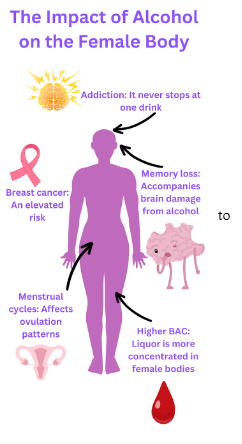After I graduated high school this May, I discovered a very surprising fact about my classmates: out of the 75 women in my high school class, 50 of them drank every weekend before they even turned 18. Whether it was asking for espresso martinis at graduation parties or posting pictures of Twisted Teas, I knew it was unusual for ⅔ of my classmates to have one foot in the door of alcohol abuse. Unfortunately, this is a nationwide epidemic: over 6.8 million females aged 12-20 have had at least one alcoholic beverage in their lives, and this has increased dramatically in the last 20 years for young women in particular (National Institute on Alcohol Abuse and Alcoholism, 2024). But why?
Bottoms Up?
Alcohol misuse is characterized for women as more than one drink per day on average and binge drinking, more common in younger women, is defined as 4 or more drinks on a single occasion (Centers for Disease Control and Prevention, 2024). In the 1990s, alcohol consumption, misuse, and binge drinking between men and women were at a 3 to 1 ratio. Today, that number has skyrocketed to a 1 to 1 ratio, and has been particularly harmful to younger women, who may drink with their friends in high school or college (Slade et al., 2016, 1-12). In fact, at Columbia University, 86% of undergraduate students drink, indicating that most drinkers are underage (Run & Master, 2001). This disproportionately affects young women, who often drink because of stress or mental health issues and cannot stop (Pattani, 2021). To make matters worse, certain types of alcohol are directly marketed to this vulnerable population.
The New Femininomenon
While the pink tax is commonplace in everyday goods, the alcohol industry has opened a new window to this casual sexism. With Johnnie Walker turning into Jane for International Women’s Day, buying more expensive Chick Beer instead of Bud Light, and making seltzers look like a quick “spa day spritz,” these alcoholic beverages targeting women aren’t just harmful: they’re also more expensive (Emslie, 2020). Women will pay more than 13% more for the same goods as men, just because they are marketed toward women (Duffin & Smith, 2018). When a young woman sees a pink White Claw in an advertisement about a relaxing 4th of July party, she is influenced to relax just the same with a cute drink. This new marketing strategy hurts millions of young women and has even caused a public health crisis.
Martinis, Margaritas, and Mammograms
Alcohol abuse in young women may cost money and create an addiction, but that’s not all. Repeated alcohol abuse has a close correlation with breast cancer diagnoses: binge drinkers are 1.6 times more likely to have breast cancer, which already affects over 2 million women worldwide. Alcohol of course is correlated to brain damage, but the occurrence of memory loss in young women is much more common than in young men. Furthermore, drinking alcohol at a young age can cause irreparable damage to menstrual cycles and ovulation patterns. This is because liquor is more concentrated in female bodies, as women have less water in their bodies and higher body fat than men, resulting in what would be the same amount of alcohol dispersed in a smaller space. This is why so many more issues accompany heavy alcohol use in women compared to men (Mumenthaler et al., 1999, 55-64).

Girls Just Wanna Have Fun!
Alcohol abuse has damaging repercussions on young women, ranging from addiction to financial burden to even cancer. However, it isn’t a permanent problem: rehabilitation programs, therapy, or even addiction awareness can make a big difference. Even a single sip can cause a lifetime of alcohol abuse. To that, I say, the first step is always the hardest, but also the most rewarding.
References
Centers for Disease Control and Prevention. (2024, May 15). Alcohol Use and Your Health | Alcohol Use. CDC. Retrieved July 24, 2024, from https://www.cdc.gov/alcohol/about-alcohol-use/index.html
Duffin, K., & Smith, S. V. (2018, November 13). The Problem With The Pink Tax : Planet Money. NPR. Retrieved July 24, 2024, from https://www.npr.org/sections/money/2018/11/13/667539767/the-problem-with-the-pink-tax
Emslie, C. (2020, September 24). The feminisation of alcohol marketing. BBC. Retrieved July 24, 2024, from https://www.bbc.com/worklife/article/20200924-the-feminisation-of-alcohol-marketing
Miller, L. (2024, March 8). Women & Alcohol: Statistics, Side Effects & Health Impacts. American Addiction Centers. Retrieved July 24, 2024, from https://americanaddictioncenters.org/alcohol/risks-effects-dangers/women
Mumenthaler, M., Taylor, J., O'Hara, R., & Yesavage, J. (1999). Gender Differences in Moderate Drinking Effects. Alcohol Research & Health, 23(1), 55-64. https://www.ncbi.nlm.nih.gov/pmc/articles/PMC6761697/pdf/arh-23-1-55.pdf
National Institute on Alcohol Abuse and Alcoholism. (2024). Underage Drinking in the United States (ages 12 to 20). National Institute on Alcohol Abuse and Alcoholism (NIAAA). Retrieved July 24, 2024, from https://www.niaaa.nih.gov/alcohols-effects-health/alcohol-topics/alcohol-facts-and-statistics/underage-drinking-united-states-ages-12-20
Pattani, A. (2021, June 9). More Young Women Are 'Drinking To Cope,' In A Dangerous Trend : Shots - Health News. NPR. Retrieved July 24, 2024, from https://www.npr.org/sections/health-shots/2021/06/09/1003980966/women-now-drink-as-much-as-men-and-suffer-health-effects-more-quickly
Run, J. G., & Master, J. (2001, September 24). Fight for Your Rights. The Fed. https://www.columbia.edu/cu/thefed/v3/volume17/2/alcohol.shtml
Slade, T., Chapman, C., Swift, W., Keyes, K., Tonks, Z., & Teesson, M. (2016, August 1). Birth cohort trends in the global epidemiology of alcohol use and alcohol-related harms in men and women: systematic review and metaregression. BMJ Journals, 6(10), 1-12.
